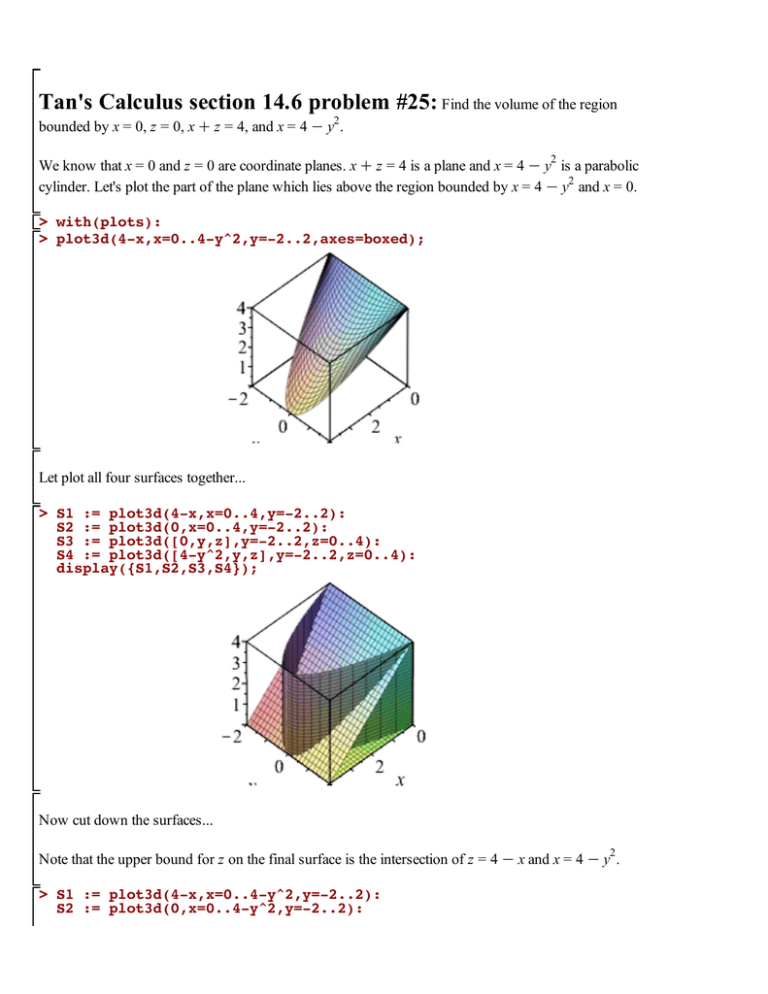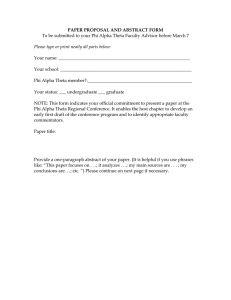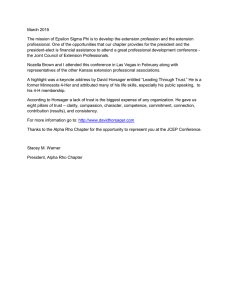Tan`s Calculus section 14.6 problem #25:Find the volume of the region
advertisement

Tan's Calculus section 14.6 problem #25: Find the volume of the region
bounded by x = 0, z = 0, x C z = 4, and x = 4 K y2 .
We know that x = 0 and z = 0 are coordinate planes. x C z = 4 is a plane and x = 4 K y2 is a parabolic
cylinder. Let's plot the part of the plane which lies above the region bounded by x = 4 K y2 and x = 0.
> with(plots):
> plot3d(4-x,x=0..4-y^2,y=-2..2,axes=boxed);
Let plot all four surfaces together...
> S1 := plot3d(4-x,x=0..4,y=-2..2):
S2 := plot3d(0,x=0..4,y=-2..2):
S3 := plot3d([0,y,z],y=-2..2,z=0..4):
S4 := plot3d([4-y^2,y,z],y=-2..2,z=0..4):
display({S1,S2,S3,S4});
Now cut down the surfaces...
Note that the upper bound for z on the final surface is the intersection of z = 4 K x and x = 4 K y2 .
> S1 := plot3d(4-x,x=0..4-y^2,y=-2..2):
S2 := plot3d(0,x=0..4-y^2,y=-2..2):
>
S3 := plot3d([0,y,z],y=-2..2,z=0..4):
S4 := plot3d([4-y^2,y,z],y=-2..2,z=0..4-(4-y^2)):
display({S1,S2,S3,S4});
The volume is the triple integral of 1.
> Int(Int(Int(1,z=0..4-x),x=0..4-y^2),y=-2..2) = int(int(int(1,z=0..4
-x),x=0..4-y^2),y=-2..2);
2
Ky2 C 4 4 K x
1 dz dx dy =
K2 0
0
128
5
An example using rectangular, cylindrical, and spherical
coordinates.
> with(plots):
> top := plot3d([5*cos(theta)*sin(phi),5*sin(theta)*sin(phi),5*cos
(phi)],phi=0..arctan(3/4),theta=0..2*Pi):
bottom := plot3d([r*cos(theta),r*sin(theta),4],r=0..3,theta=0..2*
Pi):
display({top,bottom},scaling=constrained,axes=boxed);
(1)
sin x2 C y2 C z2 dV where E is the region inside x2 C y2 C z2 = 25 and
We wish to compute
E
above z = 4.
Note: "int" is Maple's integrate command. "Int" is Maple's "inert" integrate command. The inert command
represents an integral, but doesn't actually go through with the computation. To actually evaluate inert
commands right-click on the blue output and choose "Evaluate (from inert)".
To compute iterated integrals, we simply stick int commands inside of other int commands.
Rectangular:
> Int(Int(Int(sin(x^2+y^2+z^2),z=4..sqrt(25-x^2-y^2)),y=-sqrt(9-x^2).
.sqrt(9-x^2)),x=-3..3);
3
Kx2 C 9
Kx2 K y2 C 25
2
2
sin x C y C z
K3
K Kx2 C 9
2
dz dy dx
(2)
4
> # I gave this one a minute or two, but Maple never got back with an
answer. :(
# int(int(int(sin(x^2+y^2+z^2),z=4..sqrt(25-x^2-y^2)),y=-sqrt(9x^2)..sqrt(9-x^2)),x=-3..3);
Cylindrical:
> Int(Int(Int(sin(r^2+z^2)*r,z=4..sqrt(25-r^2)),r=0..3),theta=0..2*
Pi);
2p 3
0
Kr 2 C 25
sin r2 C z2 r dz dr dq
(3)
0 4
> int(int(int(sin(r^2+z^2)*r,z=4..sqrt(25-r^2)),r=0..3),theta=0..2*
Pi);
(4)
K
1
2
2 p
3/2
FresnelC
4
2
C
p
1
2
2 p
3/2
FresnelC
5
2
p
K cos 25 p
(4)
Spherical:
> Int(Int(Int(sin(rho^2)*rho^2*sin(phi),rho=4*sec(phi)..5),phi=0..
arctan(3/4)),theta=0..2*Pi);
2p
0
arctan
0
3
4
5
sin r
2
2
r sin f dr df dq
(5)
4 sec f
> int(int(int(sin(rho^2)*rho^2*sin(phi),rho=4*sec(phi)..5),phi=0..
arctan(3/4)),theta=0..2*Pi);
1
3/2
4 2
1
3/2
5 2
K
2 p
FresnelC
C
2 p
FresnelC
K cos 25 p
2
2
p
p
(6)
The answer approximated...
> evalf(int(int(int(sin(rho^2)*rho^2*sin(phi),rho=4*sec(phi)..5),phi=
0..arctan(3/4)),theta=0..2*Pi));
K3.060528180
(7)
The centroid of our region...
> m := int(int(int(1*rho^2*sin(phi),rho=4*sec(phi)..5),phi=0..arctan
(3/4)),theta=0..2*Pi);
14
m :=
p
(8)
3
> Myz := int(int(int(rho*cos(theta)*sin(phi)*rho^2*sin(phi),rho=4*sec
(phi)..5),phi=0..arctan(3/4)),theta=0..2*Pi);
Myz := 0
(9)
> Mxz := int(int(int(rho*sin(theta)*sin(phi)*rho^2*sin(phi),rho=4*sec
(phi)..5),phi=0..arctan(3/4)),theta=0..2*Pi);
Mxz := 0
(10)
> Mxy := int(int(int(rho*cos(phi)*rho^2*sin(phi),rho=4*sec(phi)..5),
phi=0..arctan(3/4)),theta=0..2*Pi);
81
Mxy :=
p
(11)
4
> Centroid := 1/m*<Myz,Mxz,Mxy> = evalf(1/m*<Myz,Mxz,Mxy>);
0
0.
0
0.
Centroid :=
=
(12)
243
4.339285714
56




